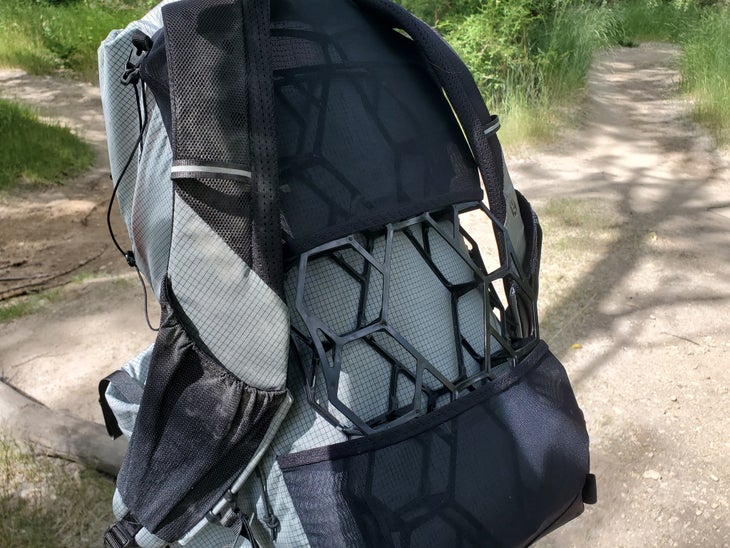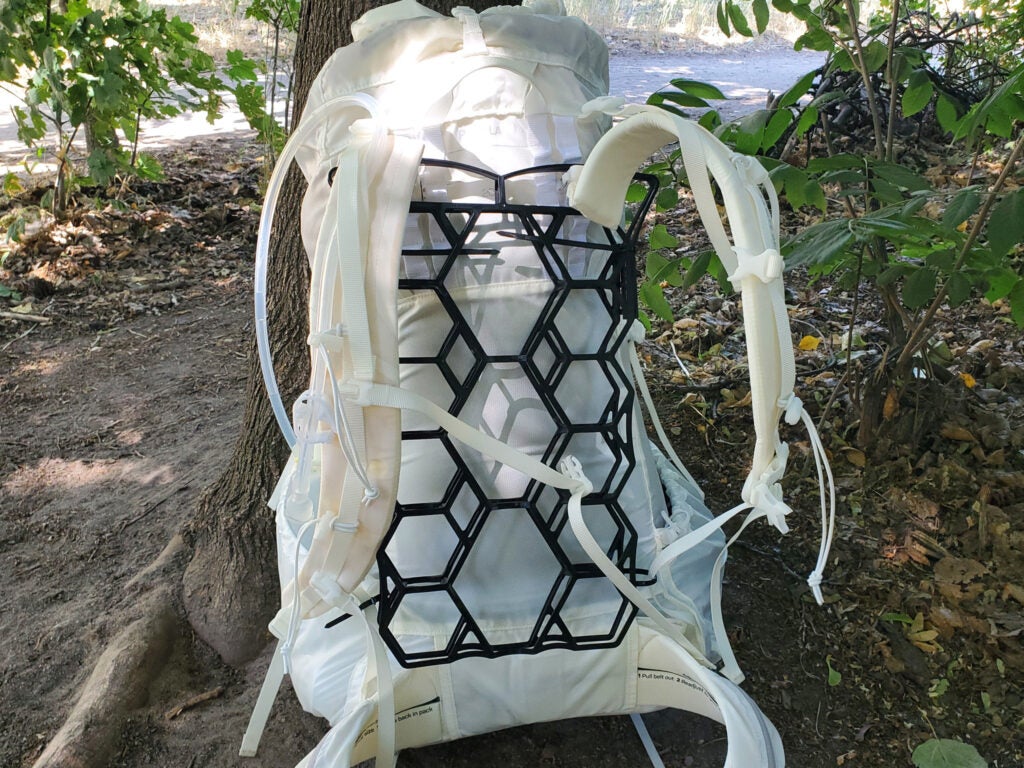“], “filter”: { “nextExceptions”: “img, blockquote, div”, “nextContainsExceptions”: “img, blockquote, a.btn, a.o-button”} }”>
Heading out the door? Read this article on the new Outside+ app available now on iOS devices for members!
>”,”name”:”in-content-cta”,”type”:”link”}}”>Download the app.
No one likes a sweaty back. But for ultralight hikers who prefer small, simple, frameless backpacks, a lack of airflow has always been one of the tradeoffs for a lighter baseweight. Unlike the perforated foam panels and trampoline mesh systems found on mainstream packs, ultralight options often have nothing separating you from the sticky nylon of the pack itself. For some, it’s even a health issue: one of my sweatier friends developed a staph infection on his back from the constant chafing and sweating he endured while hiking the AT.
The Vaucluse Ultralight Backpack Ventilation Frame ($40) promises to solve this problem by placing a 3.4-ounce, removable plastic grid between your body and your backpack. We got our hands on one to see how well it works in the real world.
Ventilation
There are plenty of pros and cons to the Vaucluse frame, but one thing is for sure: it does what it’ supposed to do—provide some much-needed airflow to your back. It features a plastic lattice structure that measures over an inch thick, providing a bigger air buffer than any simple foam back pad ever could. Add it to your pack, and the difference is immediately apparent.
We quickly found that the Vaucluse requires the right backpack to work well, though. Daypacks and small frameless packs without a hipbelt? Ideal. Larger packs with suspension or substantial hipbelts? Not so much.
The reason: A hipbelt requires a secure and tight connection around your lower back and hips in order to work as intended. We tested the Vaulcuse frame with a number of different men’s packs (medium and large sizes). In every case, it sat above the hipbelt and lumbar pad. That means it provides ventilation to the middle of the back, but doesn’t solve the issue of a sweaty lower back. That was true for heavyweights like a Mystery Ranch Bridger 65 and ultralight packs like the Granite Gear Virga 55. In general, packs like this make the Vaucluse about as effective as a “trampoline back” design found on the likes of the Osprey Exos.
In contrast, the frame works quite well without a hipbelt. Without the extra tension in the lumbar region, it creates an air buffer along the entire length of your back. It also pulls double duty as a suspension frame, providing a bit of structure and support in frameless packs. With frameless packs, a trampoline back design is impossible, so something like the Vaucluse is really the best and only option to boost airflow.
Comfort
Pressed into your back, the Vaucluse offers middling comfort. It feels a bit like the bumpy soles you’d find on Crocs and other sandals. I didn’t mind the feeling, but it didn’t make any pack I tested more comfortable. The frame was both stronger and more flexible than I expected, and it did conform to the shape of my back after some use. As with airflow, pack weight and size made a big difference in terms of comfort. A 10- to 20-pound pack with no hipbelt was no big deal. A 35-pound load with the hipbelt cinched tight? You start to notice the stiff plastic lattice shifting against your back before too long.
Vaucluse does make a mesh sleeve that can be fitted over the frame to provide some extra padding (with a weight penalty of two ounces.) We found it to be far more comfortable with the sleeve, but it’s also another layer of fabric against your skin to trap heat and hold on to sweat. If breathability is paramount, ditching the sleeve is the way to go.
Setup
Latching the Vaucluse to your pack is fairly simple. The frame is essentially two plastic lattice structures that press together. It secures to a pack with two adjustable plastic loops that go around the top of each shoulder strap. The loops can be attached to three different tabs, which changes the length of the frame to better fit your pack size. It also comes with six reusable zip ties—four to secure the loop connections up top and two to attach the frame to the webbing between the pack body and shoulder straps, which prevents the bottom of the frame from sliding around. The zip ties work well enough, but they are far from an elegant solution. They have to be situated correctly to make sure they don’t poke against your back, and keeping track of them when switching the frame between packs is a pain (I lost several ties during testing).
If you’re using a pack with an external pad sleeve, like something from Gossamer Gear, you’re in luck: Simply remove the pad and put the frame in the sleeves instead—you won’t have to worry about zip ties or attaching the frame over the shoulder straps at all.
All together, the Vaucluse is designed well enough for the average ultralighter who’s used to finicky trekking pole tents and other weight-saving hacks, but would be annoying for a more casual backpacker.

Who Should Buy the Vaucluse Frame?
In all, the Vaucluse is a piece of kit that does what it advertises, but is most useful in a fairly narrow set of circumstances. If you use framed packs with substantial hipbelts, upgrading to a pack with a trampoline back is a more comfortable solution to sweat management (the 3FUL Tianshan is one affordable option). If you use frameless packs with a minimal hipbelt or no hipbelt at all, however, the Vaucluse might be the only ventilation option available, and it works quite well. It sacrifices a bit of comfort in terms of pack feel against your back, but adds a lot of comfort in ventilation—my back was noticeably less sweaty after a long dayhike in 90-degree weather in central Idaho. The frame pairs well with daypacks, as well, and makes all sorts of outdoor activities, like bike commuting and traveling, more bearable in hot weather.
